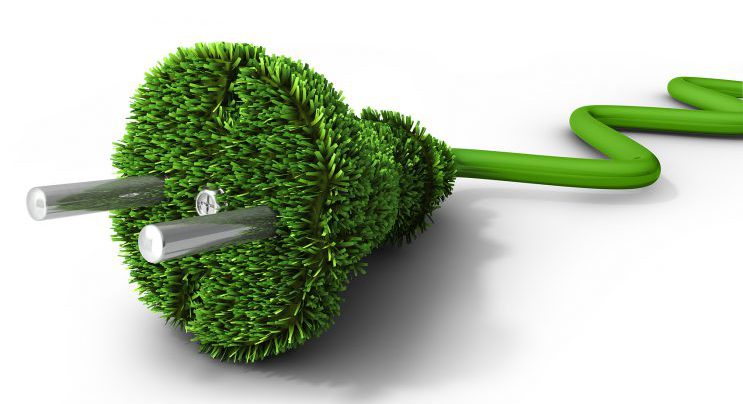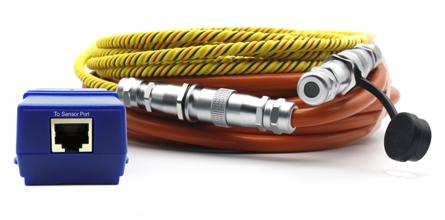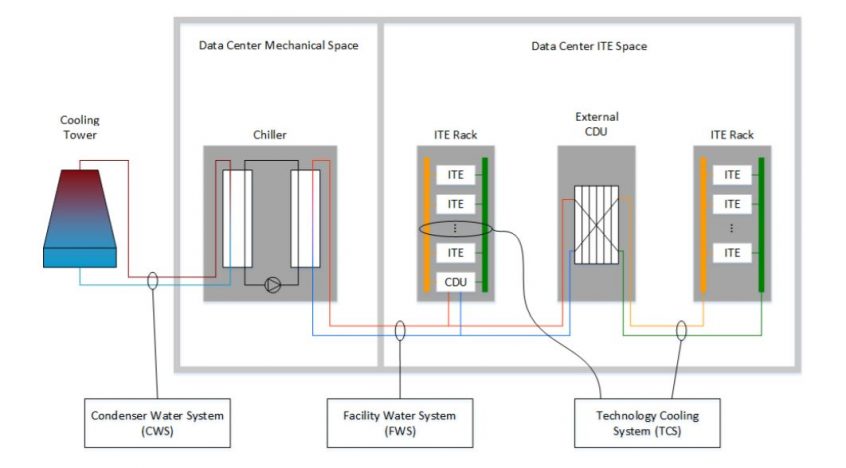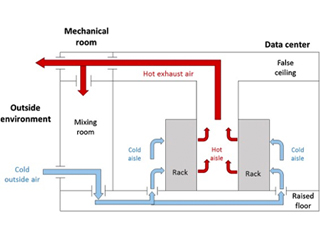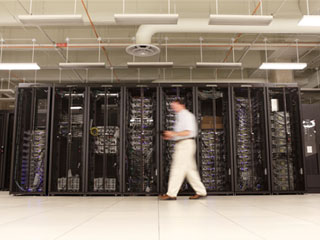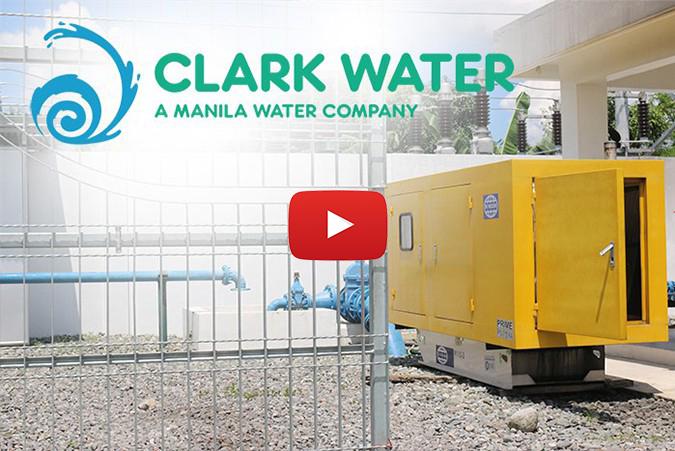The digital world has forced the expansion of data centers, with more edge, and hyper-scale data centers being built. According to Natural Resources Defense Council (NRDC), data centers used 91 billion kilowatt-hours (kWh). Their carbon emissions account for 200 million metric tons of carbon dioxide in a year. Keeping the data centers cool is one of the biggest energy hogs.
Different approaches are taken to cooling, but most large data centers utilize chilled water cooling. Some have experimented with liquid cooling technology and rear door heat exchangers (RDHx) but these were mostly limited to high-density racks, not the whole data center. Chilled water cooling systems started to go mainstream as density and sustainability became the talk of the industry. Water is more efficient at transferring heat and removing hotspots. However, sustainability of water use with ever-increasing populations and demands on water resources is a concern. Some data centers simply can’t get any more water, meaning the current cooling capacity is capped.
Data Center Sustainability
Data centers are now at the center of government and environmental advocates’ attention. They demand the administrators’ compliance with sustainable infrastructure. Data centers must be built with a commitment to innovative and sustainable strategies by using science-driven solutions. This includes green power, water conservation, recycling, and waste management.

Photo Credit: datacenterfrontier.com
The Green Grid (TGG) aims to help data centers understand and improve their sustainability. It also helps them make informed decisions. TGG proposes metrics to assess the data center’s efficiency, thus minimizing its impact on the environment. These are:
-
Power usage effectiveness (PUE)
-
Data Center Energy Productivity (DCeP)
-
Energy Reuse Effectiveness (ERE)
-
Data Center Compute Efficiency (DCE)
-
Carbon Emission Effectiveness (CUE)
-
Water Usage Effectiveness (WUE)
The world’s water usage rises by about 1% every year. which means a 30% increase by the year 2050. In 2018, large enterprises consumed a vast amount of water of which the majority went to its data centers. 2018 water usage for the big data center players equates to 15.79 billion liters for Google and 3.5 billion liters for Microsoft. Water Scarcity is an impending global problem. Therefore, data centers that use water cooling solutions must work to reduce water usage.
Water Usage Effectiveness (WUE) is a parameter in the data center that analyzes how efficiently water is being utilized. It has become the natural extension of PUE – which measures how efficiently power is being utilized. Knowing WUE determines the necessary energy efficiency and/or sustainability improvements. It is defined as annual site water usage divided by IT Energy Usage.

Photo Credit: se.com
Unfortunately, only a few data centers track this metric and work with water conservation. One of these is Facebook showing transparency on their sustainability report. As part of their commitment to water stewardship, they reduce their water footprint by restoring the water they consume in water-stressed regions.
How to Achieve the Best WUE?
Having the lowest possible Water Usage Effectiveness should be one of the goals of the data center’s sustainability plan. Fortunately, there are measures that the administrators can perform to make this goal achievable. This checklist can save data center water usage if done consistently.
1. Recycled Water- Amazon data center uses non-potable water for cooling purposes. It is the pioneer in using recycled water with its direct evaporative cooling technology.
2. Increasing Cycles of Concentration- it is usually two to four cycles of concentration but increasing it to six may be workable. It reduces cooling tower make-up water by 20% and cooling tower blowdown by 50%.
3. Raise Temperature and Humidity- setting the data center on the highest allowable data center will require the air-conditioning system less water. Humidity can also be raised from 50 percent to 60 percent with no adverse effects. Temperature and Humidity Sensors are used in this practice.
4. Water Treatment– appropriate treatment removes scale-forming minerals and reuse water for more cycles. Acid treatments such as sulfuric, hydrochloric, or ascorbic acid can be very effective in treating water.
5. Water Efficiency Metrics- regardless of what cooling strategy is used, consistent monitoring is critical. This will determine the condition of the data center in real-time and how well the strategy is implemented.
Recommended Cooling Strategies
Different cooling strategies can be implemented in data centers to leverage sustainability. Choosing the best one may vary based on the location, available resources, data center design, and budgetary consideration. Administrators need to review every factor to determine the best strategy that meets the need of the facility. Having more choices could be overwhelming. A thorough pre-analysis will maintain long-term effectiveness.
1. Using Air-Cooler
For data centers located in areas with limited water sources, a close loop cooling system that uses an air-cooled chiller can be a feasible solution. It is paired with an air condenser to remove heat without leaking outside air into the enclosure. The air-cooled chiller serves as the primary cooling solution and is connected to several Computer Room Air Handlers (CRAH). The naturally closed loop air-cooled chiller absorbs the heat from the process water ensuring zero water loss. This results in a significant reduction of the Water Usage Effectiveness.
The predicted water shortages in the coming years plus the rising cost of water treatment and sanitary disposal, made the data centers take a second look at the air-cooled chiller. The system components are evaporator, compressor, expansion valve, and condenser where each plays a role in the cooling process. It starts with the evaporator where heat is drawn into liquid refrigerant. The compressor provides the driving force that pulls the refrigerant vapor from the evaporator delivering it to the condenser’s horizontal pipes. It dissipates the heat to the air/water and moves through the expansion device. It expands the refrigerant from water to air before it enters the evaporator. With this, the refrigerant pressure and temperature caused by the condenser are reduced.
Advantages of this system:
Disadvantages of this system:
2. Using Water-Cooled Chiller
Data centers that are located in central cities can use water-cooled chillers that work with the CRAH. It is also most effective for a low-humidity environment with higher temperatures and adequate water sources. It is installed within the facility that is connected with the condenser water loops. In the water-cooled chillers, the water evaporates through the cooling tower. This results in consistent demand for water to replace the evaporated one. With this, it is also referred to as an “Open Loop Cooling System”. This does not contribute to the overall data center Water Usage Effectiveness.
Advantages of this system:
Disadvantages of this system:
-
Risk of contaminants getting into the cooling tower
-
Extreme weather that evaporates and freezes the cooling tower
-
Consistent monitoring of the water-level
-
More complex maintenance
-
Risk of water leakage
3. Using Adiabatic Coolers
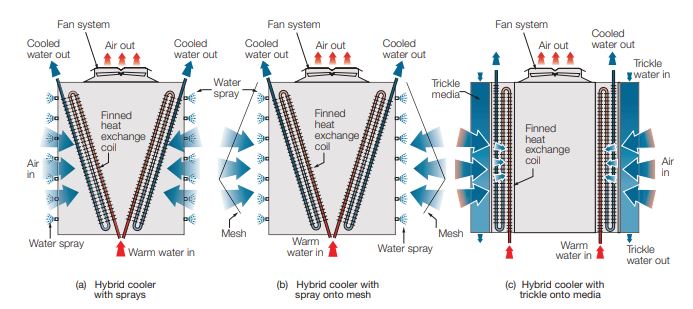
Photo Credit: www.vistechcooling.co.uk
Water-cooled chiller plants can work with adiabatic dry coolers to make them more sustainable. This system is a combination of a cooling tower and air cooling. They are ideal for areas with dry and higher temperatures by moisturizing the HVAC system condenser coils. Adding an adiabatic cooler to the existing data center can result in a significant reduction in WUE. This solution uses up 80% less water compared to the traditional evaporative unit. It also uses less energy than the air-cooler. Reducing the size of costly backup generators minimizes the cost and carbon emission. When talking about “wholesome” sustainability, this can be the best option for data center administrators.
Advantages of this system
- Addressing two issues in a single system
- High efficiency
- Cost-effective
The Importance of Monitoring
Consistent monitoring guarantees that the data center has the most optimum environment. It is also the key to keeping the cooling system functioning properly. Using sensors, real-time data is provided and problems can be pre-determined. Placing these sensors and routinely testing them protect the company’s most important assets. Indeed, most of the parameters being measured in the data center can’t be seen by human eyes. But with a reliable monitoring solution, administrators can have visibility with the server room’s condition resulting in higher security.
Specifically, integrating a monitoring system with a data-acquisition device will determine the following:
ACKP Wireless Water Distribution Control
Wireless, remote monitoring, and control of motorized ball valves in your water distribution network. Check status and remotely actuate the valves. Receive alerts when valves open and close, or automate the valve based on other sensor inputs, such as pressure gauges or flow meters.
-
4x AA Batteries
-
5VDC or 12VDC powered
-
LED indicators for power, status, and RSSI
-
Optional DIN rail or pipe mounting
-
Control direction of DC motors
-
Dry contact input for status
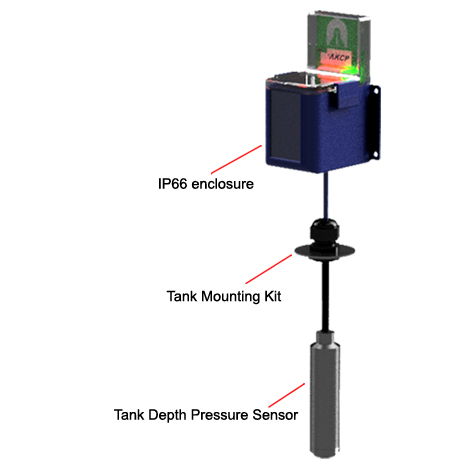
Wireless Tank Level Sensor
Monitor tanks of depths up to 20 meters. Often tanks are located in outdoor or difficult to cable areas. The WT-TDPS is battery powered or can be powered from a 5V DC or 12VDC source. Track fuel usage, graph the tank level, receive alerts when tank levels are critical. No more constraints on maximum cable lengths from the base unit
Sensor Features
- 4xAA Battery powered, with 10-year life*
- Tank mounting kit with cable gland
- IP66 rated enclosure
- Monitor all kinds of liquids and fuels.
Leak Detector

Locate Rope Water Sensor
Ideal for detecting water leaks in hard-to-see areas, such as under-raised floors and false ceilings. The Locate Rope Water sensor will give you a precise location of the water leak so you can respond promptly to protect your enterprise resources from water damage.
This sensor comes fully assembled and includes the rope portion that is the water sensing cable, the non-sensing cable (from the rope to the sensing module), and the main sensing module. The sensing cable can be pre-ordered from a 10-foot minimum to any custom run length (in multiples of 10 feet) of up to 160 feet. The non-sensing cable comes in a standard 20-foot run length.
The specific location of water along the rope can be used to trigger alerts like e-mail, SMS, phone calls, and SNMP traps. The sensor has its own SNMP OID so that it can be monitored over the network using any Network Management System.
Reference Links:
https://www.facilitiesnet.com/datacenters/article/Ensuring-Data-Center-Water-Supply-During-a-Drought–13807?source=next
https://sustainability.fb.com/report-page/water/
https://airatwork.com/wp-content/uploads/The-Green-Grid-White-Paper-35-WUE-Usage-Guidelines.pdf
https://northslopechillers.com/blog/air-cooled-chillers/
https://datacenterfrontier.com/legionella-is-the-covid-19-of-the-data-center-industry/
https://www.datacenterdynamics.com/en/opinions/adiabatic-cooling-best-of-both-worlds/
https://www.chardonlabs.com/resources/importance-of-a-closed-loop-water-system-water-treatment/
https://lifelinedatacenters.com/data-center/reduce-data-center-carbon-footprints/
